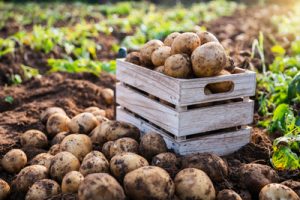Machinery and Equipment Guide
 Machinery and equipment required for potato production will vary by a grower’s preferred production method and operation size. The following discussion shares basic machinery and equipment needs for potato production. Depending on the operation size, a producer’s expertise and previous machinery investments, the grower must determine whether to purchase and operate the equipment, engage a custom service provider or possibly rent and operate the necessary equipment.
Machinery and equipment required for potato production will vary by a grower’s preferred production method and operation size. The following discussion shares basic machinery and equipment needs for potato production. Depending on the operation size, a producer’s expertise and previous machinery investments, the grower must determine whether to purchase and operate the equipment, engage a custom service provider or possibly rent and operate the necessary equipment.
Machinery and Equipment Needs
Potato growers may use various machinery operations to prepare a potato planting site. Plowing the planting site can address root-zone compaction issues. A moldboard plow is an option. Follow plowing with a disk harrow and spike-tooth harrow, which can address cloddy soil and prepare a level seedbed for planting. Some potato operations may choose to build raised beds and lay plastic mulch along with drip irrigation. If producers adopt a raised bed and plasticulture system, then they’ll require a bed shaper, mulch layer and drip irrigation system before planting. A mulch lifter would be necessary to remove the plastic mulch after the growing season.
A potato crop will grow from seed potato pieces or small whole seed potatoes. Large-scale operations that choose not to prepare seed potato pieces by hand may choose to use a seed cutting machine. To plant potatoes, the machinery choice may depend on operation size. Identify a planter that positions potatoes deep enough in the soil and simultaneously applies fertilizer and systemic insecticide.
Maintaining a potato crop involves managing insect, disease and weed pressure; hilling potato rows; supplying in-season fertilizer; and providing consistent moisture to the crop. Weed control options are varied. To kill weeds using herbicide applications, operations can administer the herbicide through a ground rig or sprinkler irrigation. A boom sprayer would be capable of applying herbicide and also insecticides and fungicides. Cultivating the production area and applying heat through flaming may also control weeds in potato crops.
For hilling, a cultivator works well for creating soil ridges over the potato rows. The choice of in-season fertilizer application equipment depends on the selected production model. A sidedress application is one possibility. Others include a topdressing applied after potatoes emerge or a foliar application. Note that a broadcast application before planting is another fertilizer application option. With respect to irrigation, overhead irrigation is an option for areas that tend to receive inconsistent rainfall during the potato growing season. Other irrigation possibilities include sprinkler, furrow and drip systems.
Before harvest, potato vines should be dead in most cases. If the crop doesn’t naturally die back to time the harvest appropriately, then operations can facilitate vine senescence by using a boom sprayer to apply a vine killer. Operations may also use a vine cutter (Locke) or a vine beater. If operations choose to harvest new potatoes before the vines have died, then they may mow the live potato plants before harvesting. New potato skin may become firmer after the plants are mowed and remain underground a few days before harvest.
Frequently, potato operations harvest their crop with mechanical harvesters that dig the potatoes and load them on a truck. Large mechanical harvesters — those that can dig two rows to four rows — are well-suited for operations that have significant potato acreage. Small harvesters capable of digging single rows are options for small-scale operations. If an operation doesn’t have access to a mechanical harvester, then hand labor would be required at harvest.
To extend the potato marketing window, operations must create a suitable storage environment. The storage site must keep humidity levels high — roughly 85 percent to 95 percent — and temperatures should range from roughly 40 degrees F to 65 degrees F, depending on the storage stage. The potato crop’s intended use may also influence desired storage temperature. Additionally, air movement is important in a storage facility. Storage facility options include refrigerated warehouses; nonrefrigerated bulk bins, which have cool air piped from the floor; and air-cooled storage rooms.
Equipment and Machinery Needs for Potato Production
|
Tractor |
X |
|
Moldboard plow |
X |
|
Disk harrow |
X |
|
Spike-tooth harrow |
X |
|
Seed cutter |
X |
|
Planter |
X |
|
Boom sprayer |
X |
|
Sidedresser |
X |
|
Cultivator |
X |
|
Harvester |
X |
|
Truck |
X |
|
Cool storage |
X |
Sources
Bogash, Steven M., William J. Lamont Jr., Lynn F. Kime and Jayson K. Harper. 2013. Potato Production . The Pennsylvania State University. State College, PA 16801.
Brandenberger, Lynn, James Shrefler, Eric Rebek and John Damicone. Potato Production . Oklahoma Cooperative Extension. Stillwater, OK 74074.
Christensen, Robert L., John Howell, Frank Mangan, Mike Sciabarrasi and Otho Wells. 2000. New England Vegetable Crop Budgets, Potatoes 1 Acre . University of Massachusetts Amherst. Amherst, MA 01003.
Kaiser, Cheryl and Matt Ernst. 2011. Potatoes. University of Kentucky. Lexington, KY 40506.
Locke, Kerry and Brenda Turner. 1995. Enterprise Budget, Potatoes, South Central Region . Oregon State University. Corvallis, OR 97331.
Midwest Vegetable Production Guide for Commercial Growers. 2017. Potato . Purdue University. West Lafayette, IN 47907.
Nair, Ajay, Donald Lewis, Vince Lawson, Laura Jesse, Lina Rodriguez-Salamanca. 2017. Commercial Potato Production Guide . Iowa State University. Ames, IA 50011.
Yanta, James P. and Cindy B. Tong. 2013. Commercial Postharvest Handling of Potatoes (Solanum tuberosum) . University of Minnesota Extension. Minneapolis, MN 55455.